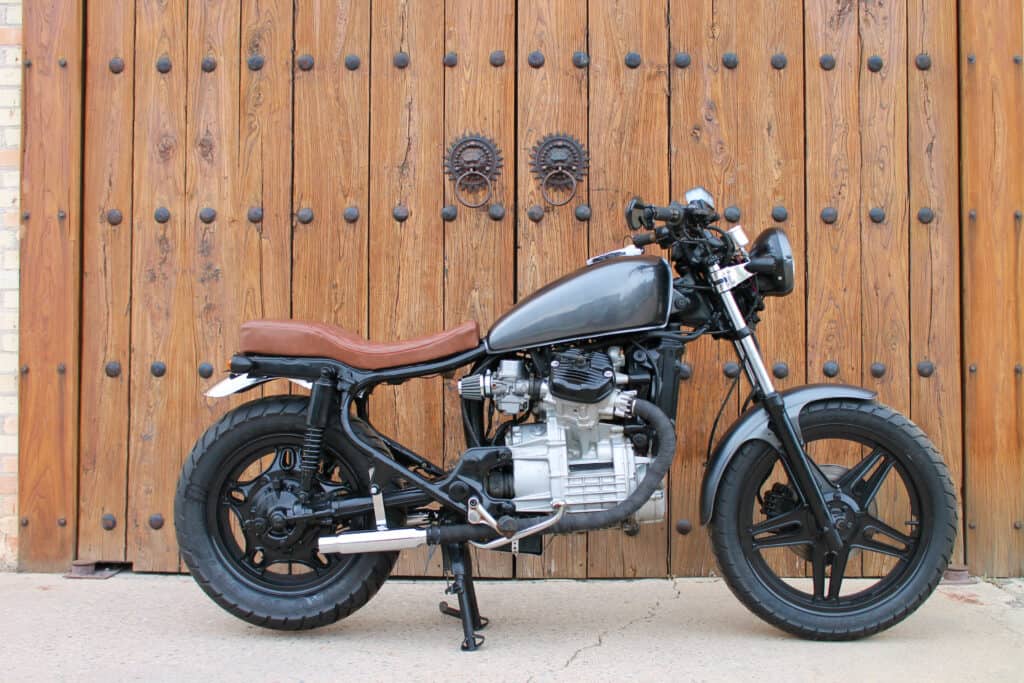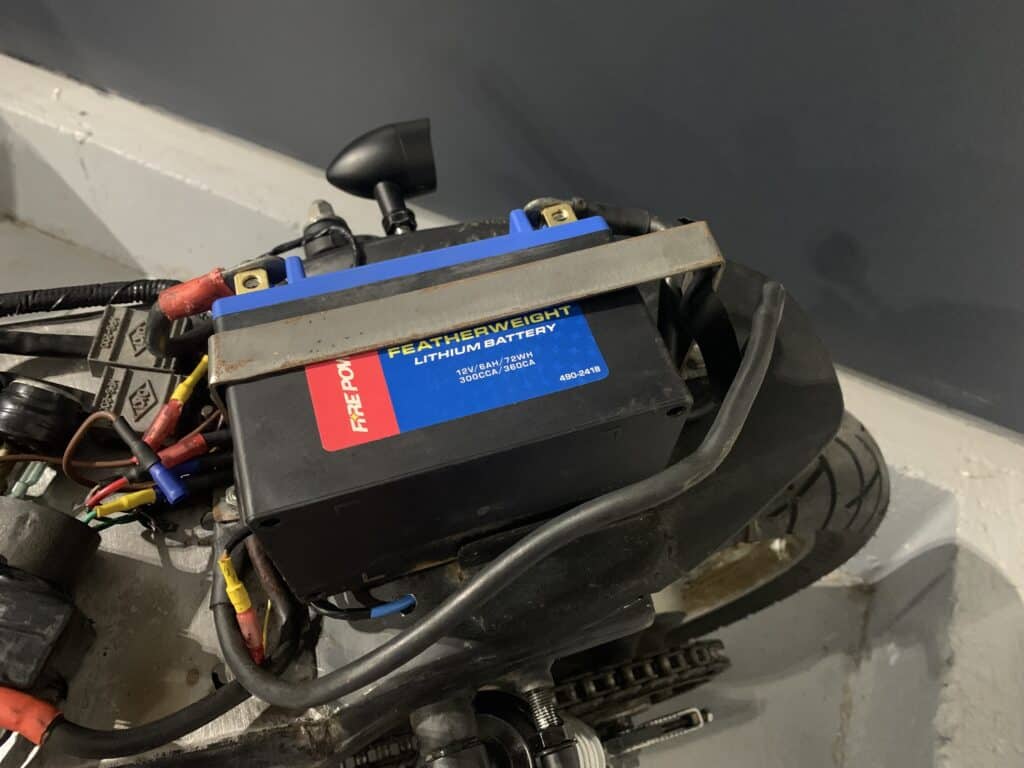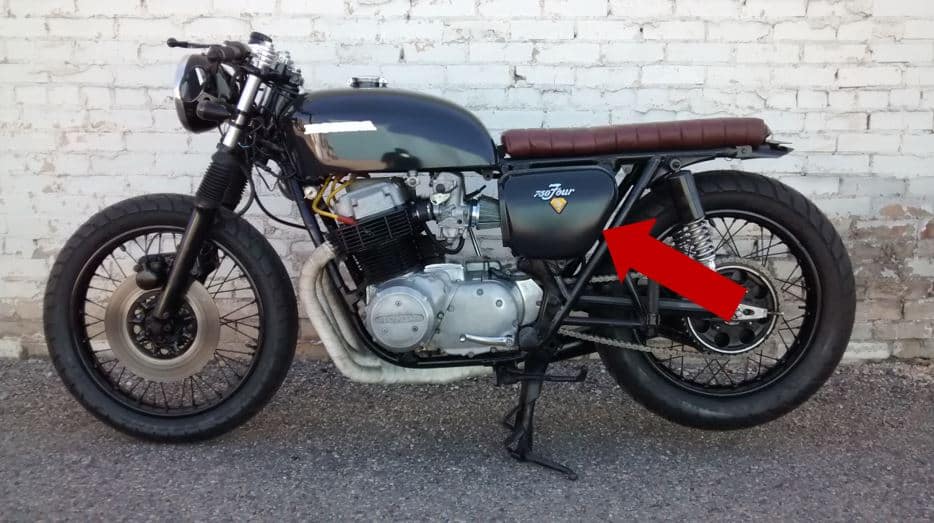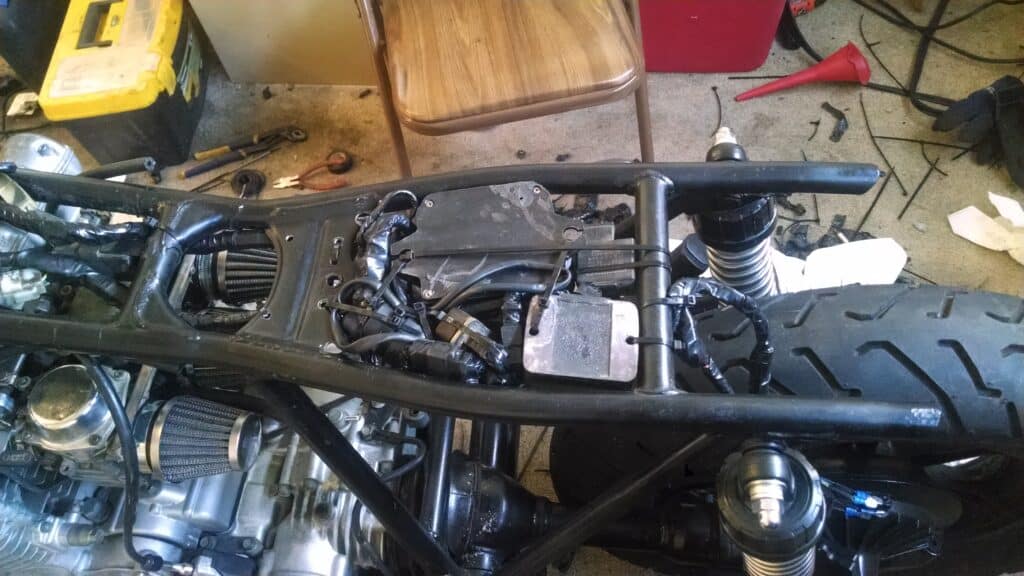
Making a motorcycle look clean and minimal is a popular approach many are pursuing today. Sometimes the bulkiness of a motorcycle can be a bit unwelcomed if you’re not into that look, so it’s no wonder you may be looking for ways to clean it up.
One component on a motorcycle that may be difficult to hide is the battery. It’s a vital component to a motorcycle, but they’re so big and awkward and can often be an eye sore if it’s put in the wrong place.
How can you hide a motorcycle battery? The best ways to hide a motorcycle battery include laying the battery flat on it’s side on the rear swing arm, mounting it in a battery box under the rear swing arm, placing it under the seat in a battery box, or installing pot filters and placing the battery in the airbox space.
I have restored dozens of motorcycles, most of which were turned in to cafe racers. Since I went with the minimal look, I had to get creative with places to hide the battery and these are the tried and true ways I always resort to. Keep on reading to see exactly how I do it.
How To Hide A Motorcycle Battery
When I was flipping motorcycles in college, I transformed most of them in to cafe racers (and it is still what I usually do with my current restorations). This type of bike has a sleek, simple look – this meant huge innovative efforts to hide the wiring and battery.
Luckily there are several places you can place your battery without compromising the functionality of it or your motorcycle. The first option you have is laying it flat on it’s side on top of the rear swing arm. This is the most common method I use.
The rear swing arm is by the rear wheel and is where the center of the hub (the axle of the rear wheel) is connected to a rectangular piece that goes up and connects to the frame (see picture below). I normally used metal plumber’s tape to fasten it to the rear swing arm.

Please note that you should only lay the battery on it’s side if you have a sealed battery. You cannot do this with an unsealed battery because it will leak (which we will go into more detail later in this article).

The second option you have is mounting the battery underneath the rear swing arm. It may sound a bit weird, but I’ve actually done this many times myself on a lot of my motorcycle restorations. I made a custom battery box from bent sheet metal; sometimes I would paint it the same color as the frame, other times I kept it bare metal to match with the engine (like it is pictured above).
After I placed the battery in the box, I fastened it to the frame with metal plumber’s tape. I only used this method when I knew there was still plenty of clearance between the road the battery, so ensure you have that if you use this method.

Another option you have to hide your motorcycle battery is placing it underneath the seat. To do this, you’ll probably need to get a smaller battery to get it to fit underneath there.
You can also place it underneath the rear seat hump. Lithium ion batteries come in very small sizes so doing this should be relatively easy. You can run the cables and wiring underneath the seat and tuck them in there nicely so you won’t be able to see any wires at all.

As another option for older motorcycles, it’s possible to take out the air box and place the battery where the air box was. If you do this, you’ll need to replace your air box with high quality pod filters.
The Best Options For Unsealed Batteries
As I had mentioned before, sometimes hiding a motorcycle battery can be difficult if you have an unsealed battery; you cannot lay it on it’s side due to leaking possibilities. But if you have an unsealed battery, you can still hide it.
If you have to keep your motorcycle battery upright, the best option you have is placing it on top of the rear swing arm. You’ll generally have several pieces of frame (at least two pieces) that connect right there. There is framing on the side profile view so it will still hide your battery nicely, even if it’s standing upright.
It’s important you understand what kind of battery you have so you can place it in the best spot possible. Putting the wrong battery on it’s side could potentially ruin your battery as well as parts of your motorcycle. To learn more about placing your motorcycle battery on it’s side, see my other article here.
How To Accommodate Wiring When Hiding Your Battery
If you are planning on placing your battery in a place other than where it was designed to be on your motorcycle, you’ll likely need to make some other accommodations to your motorcycle to make it work. Most of the time, however, these accommodations are pretty simple.
When you move your battery, you’re probably going to have to lengthen several wires. This usually isn’t a problem. All you really need to do is get some donor wire, cut the amount of extra slack you need, and splice it on to the existing wire.
To splice the wire, you’ll need to take the insulation off both wires, solder the two pieces together, and put heat shrink over the solder so water can’t get to it. Then cover the connection with electrical tape.
You’ll likely need to get longer battery cables. I recommend you simply get new, longer cables rather than try to splice them and make them longer. Battery cables are generally inexpensive and can be found at any auto store.
The best way I have found to hide the wiring is wrapping them in electrical tape and running them along the frame. There are a lot of ways you can connect the wiring to the frame, but I usually use zip ties in places you can’t easily see (use zip ties the same color as your frame). Then I ultimately hide a good chunk of the wiring underneath the seat. For more information about how to hide your motorcycle wiring, see my article here.

Do I Have To Have A Battery At All?
A common question I’ve heard among motorcycle enthusiasts is if they even need a battery at all. This would ultimately solve the problem of trying to hide the battery in the first place.
The answer, surprisingly, is that you can get away with not having a battery on your motorcycle. If you have a small enough engine (anything at 250 CC’s or smaller), there are ways to rewire your motorcycle straight from the stator to other components.
Along with having a small engine, this will only work if you have a kick starter. You can run your lights and everything else off of your stator and use the kick starter to start the engine rather than the battery. I had a friend in college who did this exact thing. He removed the battery and he was able to get around just fine.
There are some challenges that come with doing this. If the motorcycle isn’t on, your lights, horn, and blinkers will not work. It could be potentially dangerous if you get stuck out in the middle of nowhere at night with a broken down motorcycle with no lights. Also, the slower you go on your motorcycle, the dimmer your lights will be. In contrast, the faster you go the brighter and hotter your lights will get.
Conclusion
If you’re going for a minimal look on your motorcycle, hiding the battery is a great way to start. You can do this by mounting the battery on top of or underneath the rear swing arm, under the seat, or in the absent air box space.
Having restored dozens of motorcycles myself, I’ve tried all of these methods which have proven to work well. Be sure that your have a sealed motorcycle battery before placing it in any position other than upright. If you have questions about how to hide your battery, please feel free to comment or contact us, we’re happy to help!
Related Question
How long can a motorcycle sit before the battery dies? The average motorcycle battery will die after 2 – 4 months without running. Newer batteries can last longer with an average of 3 – 5 months until dying whereas older batteries will not last as long giving it an average of 1 – 3 months. Click here to see my article for more information.

